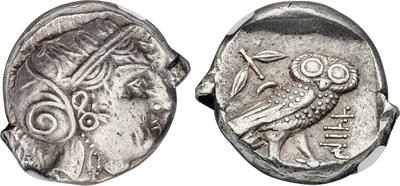Egypt (uncertain mint) (Sabakes), silver, tetradrachms (333-332 BCE)
From SILVER
333 BCE - 332 BCE Silver 5,459 kg
Description
| ObverseInscription or printing placed on the obverse.: | Head of Athena right, wearing Attic helmet ornamented with laurel leaves and vine scroll |
| ReverseInscription or printing placed on the reverse.: | (Araméen).Owl standing right, head facing, olive spray and crescent left, Aramaic MZDK right |
Mint and issuing power
| MintIdentifies the place of manufacture or issue of a numismatic object.: | Egypt (uncertain mint) | Ancient regionAncient region.: | Egypt | Modern countryModern country: Egypt | AuthorityIdentifies the issuing power. The authority can be "pretended" when the name or the portrait of X is on the coin but he/she was not the issuing power. It can also be "uncertain" when there is no mention of X on the coin but he/she was the issuing power according to the historical sources: | Mazaces (satrap of Egypt, 333-332 BC), Persian Empire, Sabaces (Achaemenid satrap of the Achaemenid 31st dynasty of Egypt, c. 350-333 BC) |
Chronology
| FromIdentifies the initial date in a range assigned in a numismatic context. | 333 BCE | toIdentifies the final date in a range assigned in a numismatic context.. | 332 BCE | PeriodTime period of the numismatic object.: Classical and Hellenistic |
Physical description
| MetalThe physical material (usually metal) from which an object is made.: | Silver |
Median weightMedian of the weights of numismatic objects (in grams). in grams | 16.90 | DenominationTerm indicating the value of a numismatic object. Examples: tetradrachm, chalkous, denarius.: | tetradrachm |
StandardStandard.: | Attic |
Image

H312 Mazaces tetradrachm.jpg [1]
References
| Die study referencePublication of the study: | Nicolet-Pierre 19791Nicolet-Pierre 1979, p. 221-30, pl. 25-26. | ||
| Coin series referenceReference to coin series study: | Sear II2Sear II, n° 6233, RQEMH3RQEMH, n° 312 | ||
| Coin series web referenceCoin series web references: | |||
Obverse dies distribution
| FrequencyFrequency of specimen in distribution. ᵖ | Number of obversesNumber of obverse dies. ᵖ (o) | % (o) | Number of coinsNumber of coins. (n) | % (n) | Die nameName(s) of the die(s). |
| 1 | 7 | 58.33 | 7 | 21.88 | 2, 3, 4, 5, 6, 7, 10 |
| 2 | 1 | 8.33 | 2 | 6.25 | 9 |
| 3 | 2 | 16.67 | 6 | 18.75 | 1, 12 |
| 8 | 1 | 8.33 | 8 | 25 | 8 |
| 9 | 1 | 8.33 | 9 | 28.13 | 11 |
| Total | 12 of 12 | 99.99 | 32 of 32 | 100.01 |
Reverse dies distribution
no distribution is available
Quantification
| Number of obversesNumber of obverse dies. ᵖ (o) | 12 | Number of singletons (o1)The number of singleton coins. ᵖ | 7 |
| Number of reverse diesNumber of reverse dies. (r) | 28 | Number of coinsNumber of coins. (n) | 32 |
| Coins per obverse dieNumber of coins per obverse die. (n/o) | 2.67 | Coins per reverse dieNumber of coins per reverse die. (n/r) | 1.14 |
| Reverse per obverse ratioRatio of obverse dies divided by reverse dies. (r/o) | 2.33 | Percentage of singletons (o1)number of coins (n) divided by the number of singletons (o1) ᵖ | 58.33 % |
| Original number of dies (O) (Carter 1983 formula)The estimation of the number of coins according to Carter 1983 ᵖ | 16.15 | Coins struck if 20,000 as average productivity per dieCoins made if the average productivity for obverses (according to Carter) is 20,000. ᵖ | 323,000 |
| Original number of dies (O) (Esty 2011 formula)The estimation of the number of coins according to the singleton formula in Esty 2011 ᵖ (O) | 19.2 | Survival rate if 20,000 as average productivity per dieSurvival rate if average productivity is 20,000. ᵖ | 0.00010 |
| Coverage (o = % of O) (Esty 1984 formula)Esty 1984 - coverage (% of O) ᵖ (o = % of O) | 78.13% | Die productivity if survival rate 1/2,000Average productivity if survival rate is 1/2,000. ᵖ | 3,962.85 |
| Weight of silver (in kg) if 20,000 coins per die (O = Carter formula)Carter 1983 * Median weight * 20000 (*10 if gold or electrum) ᵖ | 5,459 kg <br /> 5,459 kg | Die productivity if survival rate 1/5,000Average productivity if survival rate is 1/5,000. ᵖ | 9,907.12 |
Remarks
Most likely one single workstation Likely military